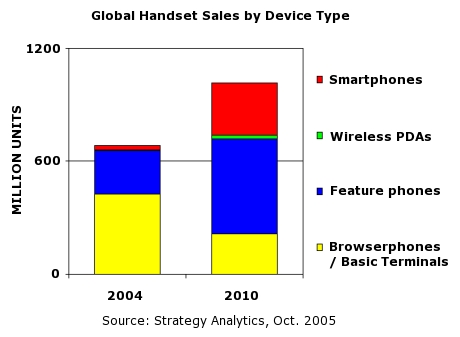Smartphone growth significant, but risks remain
Jan 24, 2006 — by LinuxDevices Staff — from the LinuxDevices Archive — viewsThe smartphone market grew over 70 percent in 2005, and will grow significantly during the next five years, according to In-Stat. However, the high-end devices risk being perceived as “very expensive feature phones” if users fail to download the applications required to make the devices more useful than lower-priced counterparts, the market research firm warns.
In-Stat says its latest market research suggests that the median number of applications downloaded by smartphone users is just one. Additionally, “the ownership of PDAs, the devices that Smartphones are meant to displace, is twice that for Smartphone users as nonusers,” the firm added.
“The problem is that current sales channels are reasonably effective at getting these devices into the hands of users, but then many users do not download the applications they say they wanted after they leave the store,” In-Stat explained.
Another risk to smartphone market growth is that “Many wireless organizations are wary of Microsoft's intentions with Windows Mobile,” In-Stat added. However, “Microsoft is working to overcome the reluctance by the wireless industry by integrating the delivery of content to Windows Mobile-based Smartphones with its server software,” the firm said.
Additionally, In-Stat noted that both consumers and the industry overall still lack a clear definition of the term, “smartphone.” Interestingly, In-Stat failed to offer its own definition. “Smartphones” are generally considered to be mobile phones that include PDA-like functionality, Web browsing, email, and media players — many features shared with lower-end feature phones — and that additionally offer users the ability to download and install desired applications that don't ship with the devices.
Strategy Analytics, meanwhile, estimated last fall that feature phones would account for around 50 percent of over 700 million mobile phones shipped in 2005, with smartphones accounting for just six percent. While acknowledging that smartphones represent the fastest growing mobile handset category percentage-wise, Strategy Analytics further projected that feature phones would become the largest mobile phone category by 2010, as indicated in the following chart.
Strategy Analytics expects feature phones to be the largest handset category by 2010, with smartphones growing fastest, percentage-wise
In-Stat analyst Bill Hughes said, “The market's growth will involve major shifts in share among the OS platforms. The winners will be Microsoft and Linux. Their growth will be at the expense of Research In Motion (RIM) and PalmSource, although these organizations will continue to see their numbers grow.”
In-Stat's complete report, entitled The Smartphone OS Wars, covers the global market for smartphones, and includes shipment forecasts by OS through 2009. It also contains results of a North American user survey of smartphone users, with data on user preferences for features and OS. And, it explores market barriers and drivers along with trends that will influence future development of the market, according to In-Stat.
This article was originally published on LinuxDevices.com and has been donated to the open source community by QuinStreet Inc. Please visit LinuxToday.com for up-to-date news and articles about Linux and open source.
